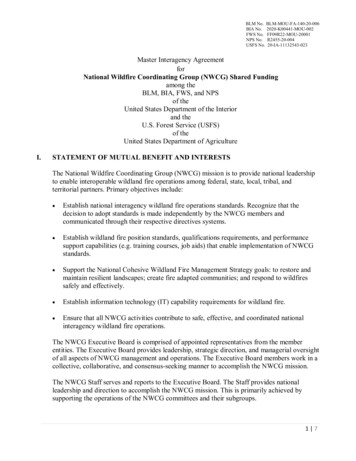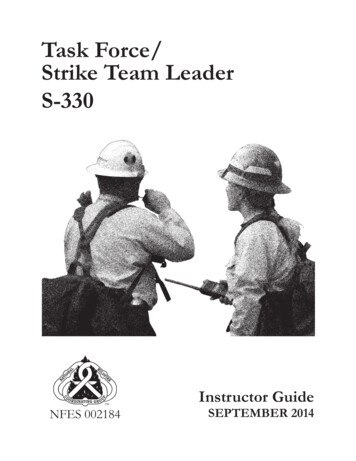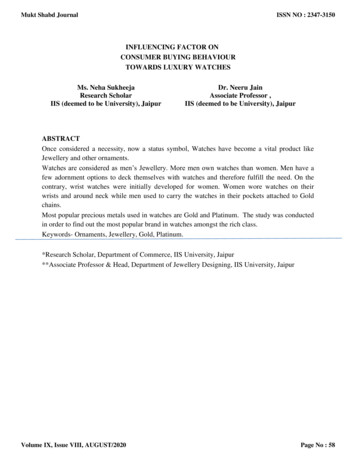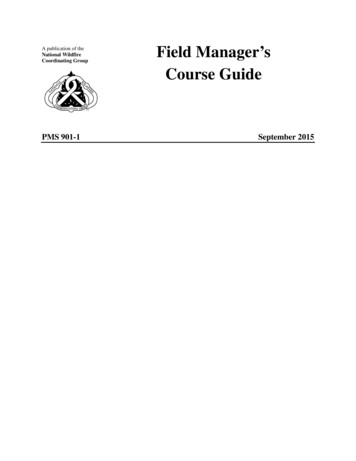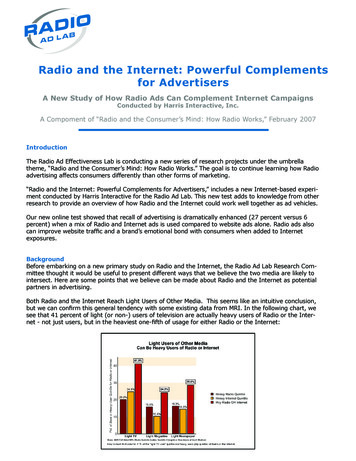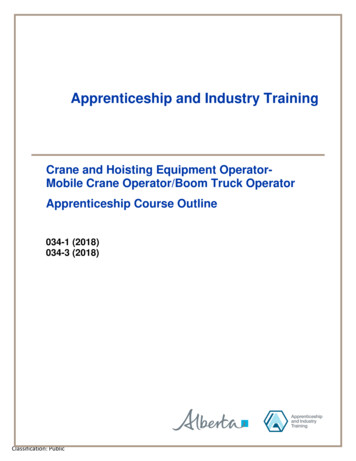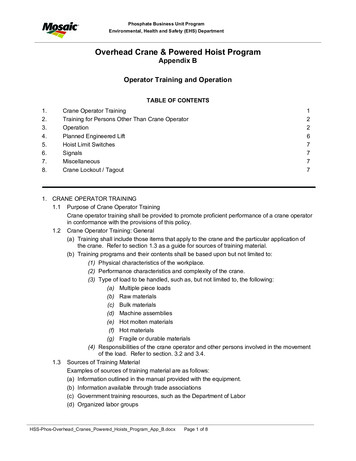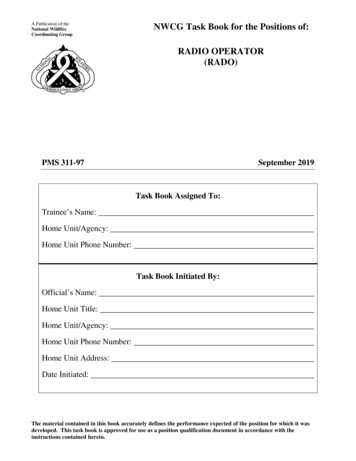
Transcription
A Publication of theNational WildfireCoordinating GroupNWCG Task Book for the Positions of:RADIO OPERATOR(RADO)PMS 311-97September 2019Task Book Assigned To:Trainee’s Name:Home Unit/Agency:Home Unit Phone Number:Task Book Initiated By:Official’s Name:Home Unit Title:Home Unit/Agency:Home Unit Phone Number:Home Unit Address:Date Initiated:The material contained in this book accurately defines the performance expected of the position for which it wasdeveloped. This task book is approved for use as a position qualification document in accordance with theinstructions contained herein.
Verification/Certification of Completed Task Bookfor the Position of:RADIO OPERATOR (RADO)Final Evaluator’s VerificationTo be completed ONLY when you are recommending the trainee for certification.I verify that (trainee name)has successfullyperformed as a trainee by demonstrating all tasks for the position listed above and should beconsidered for certification in this position. All tasks are documented with appropriate initials.Final Evaluator’s Signature:Final Evaluator’s Printed Name:Home Unit Title:Home Unit/Agency:Home Unit Phone Number:Date:Agency CertificationI certify that (trainee name)has met allrequirements for qualification in the above position and that such qualification has been issued.Certifying Official’s Signature:Certifying Official’s Printed Name:Title:Home Unit/Agency:Home Unit Phone Number:Date:This document is posted at the NWCG website: ks.2
NATIONAL WILDFIRE COORDINATING GROUP (NWCG)POSITION TASK BOOKNWCG Position Task Books (PTBs) have been developed for designated National Interagency IncidentManagement System (NIIMS) positions. Each PTB lists the competencies, behaviors and tasks requiredfor successful performance in specific positions. Trainees must be observed completing all tasks andshow knowledge and competency in their performance during the completion of this PTB.Trainees are evaluated during this process by qualified evaluators, and the trainee’s performance isdocumented in the PTB for each task by the evaluator’s initials and date of completion. An EvaluationRecord will be completed by all evaluators documenting the trainee’s progress after each evaluationopportunity.Successful performance of all tasks, as observed and recorded by an evaluator, will result in arecommendation to the agency that the trainee be certified in that position. Evaluation and confirmationof the trainee’s performance while completing all tasks may occur on one or more training assignmentsand may involve more than one evaluator during any opportunity.INCIDENT/EVENT CODINGEach task has a code associated with the type of training assignment where the task may be completed.While tasks can be performed in any situation, they must be evaluated on the specific type ofincident/event for which they are coded. For example, tasks coded W must be evaluated on a wildfire.Performance of any task on other than the designated assignment is not valid for qualification. Thecodes are defined as:O Other: In any situation (classroom, simulation, daily job, incident, prescribed fire, etc.).I Incident: Task must be performed on an incident managed under the Incident CommandSystem (ICS). Examples include wildland fire, structural fire, oil spill, search and rescue,hazardous material, and an emergency or non-emergency (planned or unplanned) event.W Wildfire: Task must be performed on a wildfire incident.RX Prescribed fire: Task must be performed on a prescribed fire incident.W/RX Wildfire OR prescribed fire: Task must be performed on a wildfire OR prescribed fireincident.R Rare event: Rare events such as accidents, injuries, vehicle or aircraft crashes occurinfrequently and opportunities to evaluate performance in a real setting are limited. The evaluatorshould determine, through interview, if the trainee would be able to perform the task in a realsituation.Tasks within the PTB are numbered sequentially; however, the numbering does NOT indicate the orderin which the tasks need to be performed or evaluated. The bullets under each numbered task are examplesor indicators of items or actions related to the task. The purpose of the bullets is to assist the evaluator inevaluating the trainee; the bullets are not all-inclusive. Evaluate and initial ONLY the numbered tasks.DO NOT evaluate and initial each individual bullet.A more detailed description of this process and definitions of terms are included in the NWCG Standardsfor Wildland Fire Position Qualifications, PMS 310-1, LITIESThe responsibilities of the Home Unit/Agency, Trainee, Coach, Training Specialist, Evaluator, FinalEvaluator and Certifying Official are identified in the NWCG Standards for Wildland Fire PositionQualifications, PMS 310-1. It is incumbent upon each of these individuals to ensure their responsibilitiesare met.3
INSTRUCTIONS FOR THE POSITION TASK BOOK EVALUATION RECORDEvaluation Record #Each evaluator will need to complete an Evaluation Record. Each Evaluation Record should benumbered sequentially. Place this number at the top of the Evaluation Record page and also use it in thecolumn labeled “Evaluation Record #” for each numbered task the trainee has satisfactorily performed.Trainee InformationPrint the trainee’s name, position on the incident/event, home unit/agency, and the home unit/agencyaddress and phone number.Evaluator InformationPrint the Evaluator’s name, position on the incident/event, home unit/agency, and the home unit/agencyaddress and phone number.Incident/Event InformationIncident/Event Name: Print the incident/event name.Reference: Enter the incident code and/or fire code.Duration: Enter inclusive dates during which the trainee was evaluated.Incident Kind: Circle the kind of incident and specify if other (ex: search and rescue, flood, etc.).Location: Enter the geographic area, agency, and state.Management Type or Prescribed Fire Complexity Level: Circle the ICS organization level or theprescribed fire complexity level.Fire Behavior Prediction System (FBPS) Fuel Model Group: Circle the Fuel Model Group letterthat corresponds to the predominant fuel type in which the incident/event occurred.G Grass Group (includes FBPS Fuel Models 1 – 3): 1 short grass (1 foot); 2 timber withgrass understory; 3 tall grass (1½ - 2 feet)B Brush Group (includes FBPS Fuel Models 4 – 6): 4 Chaparral (6 feet); 5 Brush (2 feet);6 dormant brush/hardwood slash; 7 Southern roughT Timber Group (includes FBPS Fuel Models 8 – 10): 8 closed timber litter; 9 hardwoodlitter; 10 timber (with litter understory)S Slash Group (includes FBPS Fuel Models 11 – 13): 11 light logging slash; 12 mediumlogging slash; 13 heavy logging slashEvaluator’s RecommendationFor 1 – 4, initial only one line as appropriate; this will allow for comparison with your initials in theQualifications Record.Comments: Additional information specific to the evaluator’s recommendation. The evaluatorshould note any deficiencies, additional assignment needs, or additional focus areas that wereidentified. Record additional remarks/recommendations on an Individual Performance Evaluation, orby attaching an additional sheet to the Evaluation Record.Evaluator’s Signature: Sign here to authenticate your recommendations.Date: Document the date the Evaluation Record is being completed.Evaluator’s Relevant Qualification (or agency certification): List your qualification orcertification relevant to the trainee position you supervised.Note: Evaluators must be either qualified in the position being evaluated or supervise the trainee;Final Evaluators must be qualified in the trainee position they are evaluating.4
Radio Operator (RADO)Competency: Assume position responsibilitiesDescription: Successfully assume role of Radio Operator and initiate position activities at the appropriate timeaccording to the following behaviors.TASKCODEEVAL.RECORD#EVALUATOR:Initial & dateuponcompletion oftaskBehavior: Ensure readiness for assignment.1. Obtain and assemble information and materials needed forassignment. Suggested items: Personal gear. Personal protective equipment (PPE). Appropriate office supplies.O2. Obtain complete information from dispatch upon assignment. Incident name. Incident order number. Request number. Incident phone number. Reporting time. Reporting location. Transportation arrangements/travel routes. Contact procedures during travel (telephone/radio).O3. Arrive at incident and check in. Arrive properly equipped at assigned location withinacceptable time limits.IBehavior: Ensure availability, qualifications, and capabilities of resources to completeassignment.4. Coordinate obtaining work materials and equipment. Tables. Chairs. Lights. Office supplies.5I
Radio Operator (RADO)TASKCODE5. Demonstrate familiarity with communications equipment,procedures, and basic functions/capabilities. Hand-held, portable, multi-channel radios. Radio check-in/out procedures (e.g., respond with properfrequency when requested; use accountability forms for radiocheck-in/out; issue new/replacement batteries; check-in/outappropriate radio accessories). Remote phone system (base to line, base to camp, base tohelibase). Facsimile machine.IEVAL.RECORD#EVALUATOR:Initial & dateuponcompletion oftaskBehavior: Gather, update, and apply situational information relevant to the assignment.6. Obtain initial briefing from Incident Communications CenterManager or immediate supervisor. Location of functional units at incident base camp andIncident Command Post (ICP). Time of first work period and work schedule. Specifics of Incident Action Plan (IAP) or other relevantplan(s). ICS 204, Assignment List. Specifics of ICS 203, Organization Assignment List. Specifics of ICS 205, Incident Radio Communication Plan. Specifics of ICS 206, Medical Plan and medevac process. Allocation of phones to units and existence of a phonedirectory. Procedure for processing supply orders from Operations. Message protocols. Current situation.IBehavior: Establish effective relationships with relevant personnel.7. Conduct self in a professional manner. Respectful and courteous. Respectful of public and private property.I8. Establish and maintain positive interpersonal and interagencyworking relationships.I6
Radio Operator (RADO)TASKCODEEVAL.RECORD#EVALUATOR:Initial & dateuponcompletion oftaskBehavior: Understand and comply with ICS concepts and principles.I9. Apply the ICS. Follow chain of command. Maintain appropriate span of control. Use appropriate ICS forms. Use appropriate ICS terminology.Competency: Communicate effectively.Description: Use suitable communication techniques to share relevant information with appropriate personnelon a timely basis to accomplish objectives in a rapidly changing, high-risk environment.Behavior: Ensure relevant information is exchanged during briefings and debriefings.10. Participate in daily Communications Unit briefings and meetings. Provide information on communication issues (e.g., radioequipment performance).IBehavior: Ensure documentation is complete and disposition is appropriate.11. Correctly fill out and process appropriate forms. ICS 213, General Message. ICS 210, Resource Status Change. Radio logs. Telephone logs.O12. Correctly file communications paperwork. Radio logs. Telephone logs. ICS 213, General Message. Radio check-in/out information.OBehavior: Gather, produce and distribute information as required by established guidelines andensure understanding by recipient.13. Communicate information effectively to incident personnel. Use correct radio/telephone protocols. Speak clearly and write legibly. Use standard terminology, symbols, designators, andacronyms. Acknowledge requests and provide feedback.7I
Radio Operator (RADO)Competency: Ensure completion of assigned actions to meet identified objectives.Description: Identify, analyze, and apply relevant situational information and evaluate actions tocomplete assignments safely and meet identified objectives. Complete actions within :Initial & dateuponcompletion oftaskBehavior: Take appropriate action based on assessed risks.14. Use appropriate communication protocol when responding to anincident emergency utilizing the Medical Incident Plan. This maybe accomplished by completing a scenario-based exercise on anincident.I15. Use appropriate communication protocol when receiving andprocessing supply orders.IBehavior: Transfer position duties while ensuring continuity of authority and knowledge andtaking into account the increasing or decreasing incident complexity.16. Coordinate an efficient transfer of position duties whenmobilizing/demobilizing. Document follow-up action needed and submit to supervisor.IBehavior: Plan for demobilization and ensure demobilization procedures are followed.17. Demobilize and check-out. Receive demobilization instructions from incident supervisor. If required, complete ICS 221, Demobilization Check-Out andsubmit completed form to the appropriate person.8I
Evaluation Record #Trainee InformationPrinted Name:Trainee Position on Incident/Event:Home Unit/Agency:Home Unit /Agency Address and Phone Number:Evaluator InformationPrinted Name:Evaluator Position on Incident/Event:Home Unit/Agency:Home Unit /Agency Address and Phone Number:Incident/Event InformationIncident/Event Name:Reference (Incident Number/Fire Code):Duration:Incident Kind: Wildfire, Prescribed Fire, All Hazard, Other (specify):Location (include Geographic Area, Agency, and State):Management Type (circle one): Type 5, Type 4, Type 3, Type 2, Type 1, Area CommandOR Prescribed Fire Complexity Level (circle one): Low, Moderate, HighFBPS Fuel Model Letter: G Grass, B Brush, T Timber, S SlashEvaluator’s Recommendation(Initial only one line as appropriate)1) The tasks initialed and dated by me on the Qualification Record have been performed under my supervision ina satisfactory manner. The trainee has successfully performed all tasks in the PTB for the position. I havecompleted the Final Evaluator’s Verification section and recommend the trainee be considered for agencycertification.2) The tasks initialed and dated by me on the Qualification Record have been performed under my supervision ina satisfactory manner. However, opportunities were not available for all tasks (or all uncompleted tasks) to beperformed and evaluated on this assignment. An additional assignment is needed to complete the evaluation.3) The trainee did not complete certain tasks in the PTB in a satisfactory manner and additional training,guidance, or experience is recommended.4) The individual is severely deficient in the performance of tasks in the PTB for the position and additionaltraining, guidance, or experience is recommended prior to another training assignment.Comments:Evaluator’s Signature:Date:Evaluator’s Relevant Qualification (or agency certification):sAdditional Evaluation Record Sheets can be downloaded at ks.9
Evaluation Record #Trainee InformationPrinted Name:Trainee Position on Incident/Event:Home Unit/Agency:Home Unit /Agency Address and Phone Number:Evaluator InformationPrinted Name:Evaluator Position on Incident/Event:Home Unit/Agency:Home Unit /Agency Address and Phone Number:Incident/Event InformationIncident/Event Name:Reference (Incident Number/Fire Code):Duration:Incident Kind: Wildfire, Prescribed Fire, All Hazard, Other (specify):Location (include Geographic Area, Agency, and State):Management Type (circle one): Type 5, Type 4, Type 3, Type 2, Type 1, Area CommandOR Prescribed Fire Complexity Level (circle one): Low, Moderate, HighFBPS Fuel Model Letter: G Grass, B Brush, T Timber, S SlashEvaluator’s Recommendation(Initial only one line as appropriate)1) The tasks initialed and dated by me on the Qualification Record have been performed under my supervision ina satisfactory manner. The trainee has successfully performed all tasks in the PTB for the position. I havecompleted the Final Evaluator’s Verification section and recommend the trainee be considered for agencycertification.2) The tasks initialed and dated by me on the Qualification Record have been performed under my supervision ina satisfactory manner. However, opportunities were not available for all tasks (or all uncompleted tasks) to beperformed and evaluated on this assignment. An additional assignment is needed to complete the evaluation.3) The trainee did not complete certain tasks in the PTB in a satisfactory manner and additional training,guidance, or experience is recommended.4) The individual is severely deficient in the performance of tasks in the PTB for the position and additionaltraining, guidance, or experience is recommended prior to another training assignment.Comments:Evaluator’s Signature:Date:Evaluator’s Relevant Qualification (or agency certification):Additional Evaluation Record Sheets can be downloaded at ks.10s
For 1 - 4, initial only one line as appropriate; this will allow for comparison with your initials in the Qualifications Record. Comments: Additional information specific to the evaluator's recommendation. The evaluator should note any deficiencies, additional assignment needs, or additional focus areas that were identified.
